Menu
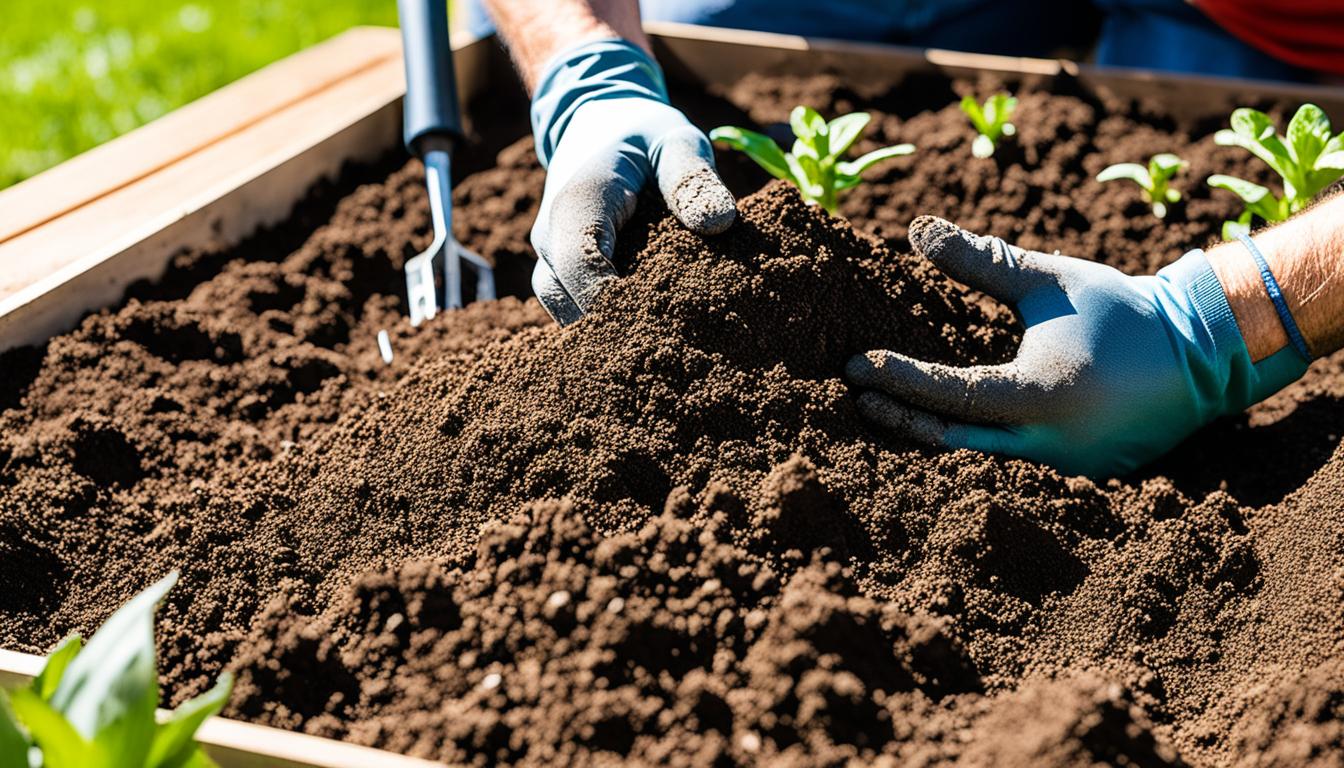
It’s wise to do a soil test every three years for your lawn and garden. This step helps match the right nutrients for best growth. Spring is a perfect time to boost your garden. But, too much fertiliser can harm plants, making them weak against bugs, diseases, and dry spells.
In spring, giving the right fertiliser at the right time is key. Different plants need different care. Cool-season grasses need nitrogen managed well. Starting spring with too much nitrogen can cause issues later. Warm-season grasses should only get nitrogen when they’re mostly green. The aim is to feed the plants enough to stay healthy all season without overdoing it.
As winter ends, spring fertilisation is key for garden health and even nutrient spread. Plants wake up after winter, needing extra nutrients to start growing again. This is vital for their overall development.
Fertilising gardens well in spring is crucial for strong plant growth. After tough winter, trees and shrubs might be weak and lack nutrients. Fertiliser helps them grow new leaves, develop roots, and become healthy. This is extra important for new trees that can’t get nutrients from soil as well as older ones.
To do spring fertilisation right, know what plants need most. Nutrients like Nitrogen, Phosphorus, and Potassium are very important for plants. Each does a different job in growth and health. It’s key to mix these nutrients right so plants don’t get too much. Too much can look like they need more nutrients, like brown leaves or dropping them.
In cities, plants often lack nutrients because of pollution. Spring is a great time to fix this. When fertilising, think about the soil, what nutrients are already there, and what plants need. This helps keep the garden looking great all spring and summer.
Choosing the right fertiliser for your garden is important for soil health. There are two main types: organic and synthetic. Organic ones come from things like animal manure and compost. Synthetic versions are made in labs. Each has its own advantages. You might like using organic fertilisers in the spring. Or you might find that synthetic ones are better for your needs. Both kinds help your garden grow well.
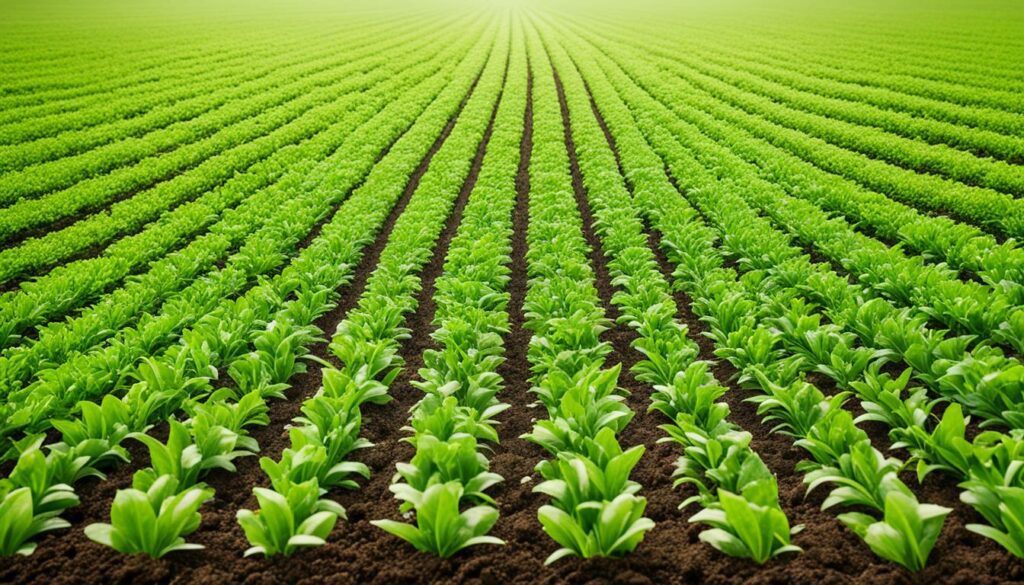
Organic fertilisers come from natural sources. These include animal waste, compost, and fish emulsion. They help soil by adding nutrients slowly as they break down. This feeds plants over time. They also make the soil better by adding organic matter. This improves soil structure and helps good microbes grow.
Using organic fertilisers is good for the planet. They are made from things that can be used again and again. This means less harm to the environment. They also make plants healthier by improving the soil. This is because organic fertilisers add nutrients that artificial ones don’t.
Synthetic fertilisers are made in factories. They give plants nutrients right away. This can be really helpful for rapidly growing plants. They come in different forms and are quick to be used by plants. So, plants grow faster and look greener soon after you use them.
But, synthetic fertilisers have downsides. They can hurt plants and the environment if you use too much. Although they are very good for quick plant growth, they don’t help the soil in the long term. They can even cause water and soil pollution. That’s why it’s best to use them carefully alongside organic fertilisers.
Choosing the right fertiliser is key to your plant’s health. You need to test your soil and know what the fertiliser labels mean. This way, your garden gets the nutrients it needs for everything to grow strong and healthy.
Getting your soil tested is really important. It tells you what nutrients your garden is missing. Experts recommend getting your soil checked every two years to see what your soil needs more of.
Soil tests look at things like pH, how much organic matter there is, and any nutrient shortages. This info helps you pick the best fertilisers for your soil. And that means you can treat your garden just right.
The kind of soil you have really matters, too. For example, sandy soil in places like Minnesota can lose nutrients easily. That’s why getting your soil tested on a regular basis is a smart move.
Understanding what’s on a fertiliser label is crucial. You’ll see numbers like 10-20-10, which stand for nitrogen, phosphorus, and potassium. These numbers tell you how much of each nutrient is in the product.
A bag of 10-20-10 with 10 pounds of nitrogen, 20 pounds of phosphorus, and 10 pounds of potassium is a good example. Plants often need more phosphorus to grow strong roots. So, you might go for a mix with higher phosphorus than nitrogen or potassium.
How much fertiliser you use depends on the kind you have. A bag of 10-20-10 might need 2 to 3 pounds for every 100 square feet of your garden. By understanding what’s on the label, you can pick the best fertiliser for your plant’s needs.
Spring is an ideal time to boost your lawn’s health. Choosing the right fertiliser is crucial for growth and beauty. The right choice will lead to a greener, more vibrant lawn that is not only beautiful but better for the planet, too.
The proper nitrogen source is key for your lawn. Nitrogen boosts grass growth. You can pick from two main sources:
Knowing the difference helps you choose what’s best for your lawn. A good balance keeps your lawn green and dense all through spring and beyond.
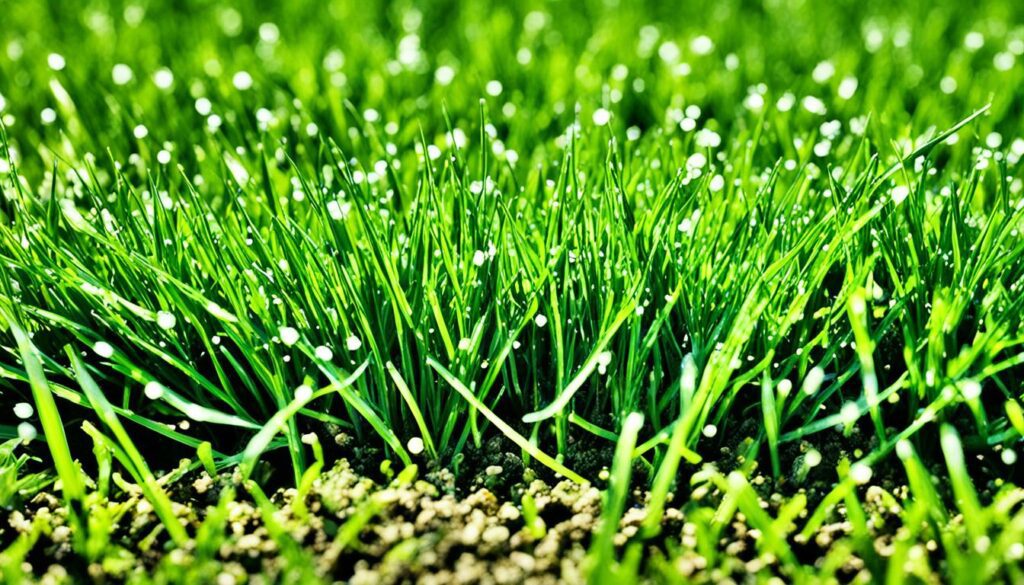
Using fertiliser properly is vital for a healthy lawn. Here are some top tips:
Following these steps helps you fertilise your lawn the right way. Both granular and liquid fertilisers work, but choose based on what suits your lawn best.
| Nitrogen Source | Advantages | Disadvantages |
|---|---|---|
| Slow-release fertilisers | Long-lasting, consistent growth, less frequent application | Initial impact is slower, can be more expensive |
| Fast-acting fertilisers | Immediate results, quick boost for struggling lawns | Requires more frequent application, risk of over-fertilising |
The best fertiliser and good application make a huge difference. Choosing wisely and using it correctly ensures a lush lawn. It supports growth and keeps your lawn looking great all season.
A balanced approach is key for spring fertilisation in flowerbeds. Slow-release fertilisers are best for plant health. They provide nutrients steadily for 3-6 months. This helps flowers all season.
Knowing what’s in your fertiliser matters a lot. The main nutrients for plant growth are nitrogen, phosphorus, and potassium. You can find their ratios on packaging, known as the NPK ratio. For flowering plants, choose a balanced formula like 20-5-10.
Timing and care are vital for flowerbeds. Use fertiliser in March or April to help flowers start blooming. Don’t use too much, as it can harm plants. Mixing granular fertilisers into the soil helps with slow nutrient release.
Compost and leaf mould are great for flowerbeds. If you top up with 1 inch of compost yearly, you might not need more fertilisers. A 1-2 inch topdressing of compost helps perennial plants a lot.
Some perennials need extra care like daylilies, peonies, mums, and tall phlox. Fertilise them in spring and add more after they bloom. But avoid late summer or early autumn fertilisation to protect your plants. They might grow too much and get hurt by winter.
| Fertiliser Type | Recommended Application | Benefits |
|---|---|---|
| Slow-release | 3-4 months or 5-6 months | Consistent nutrient supply |
| Compost | 1 inch annually | Season-long fertility |
| Granular/Pellet | Mix into soil 2-4 inches | Gradual nutrient release |
For extra help, try liquid feed on plants that look weak. Using the right fertiliser well improves plant health and makes your garden a lively place.
To get a great harvest, you must know what each plant needs. This means understanding the right nutrients for different vegetables and fruits.
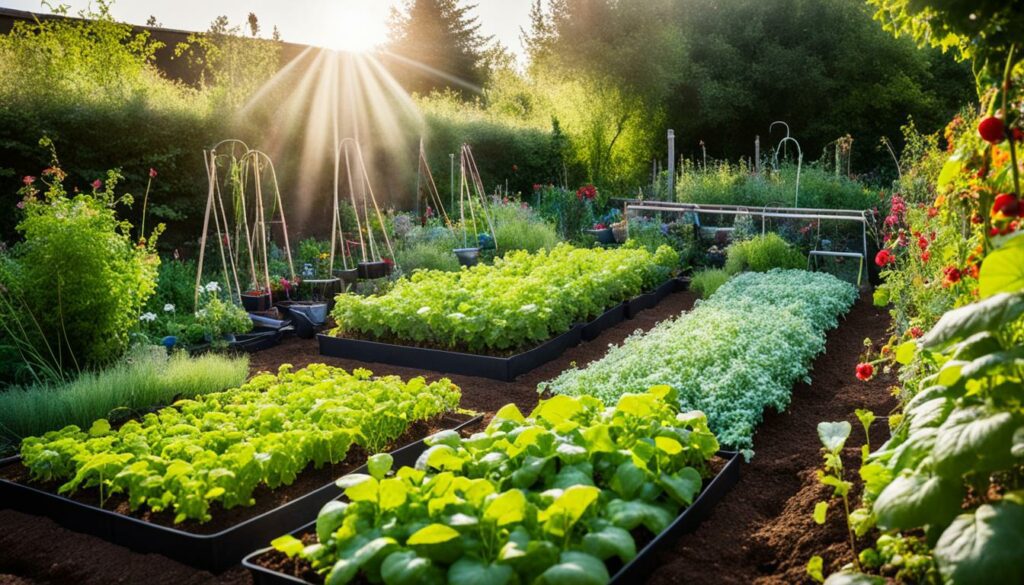
Different plants need different nutrients and in varying amounts. Tomatoes do well with a 3-4-6 ratio fertiliser. Add calcium to stop blossom-end rot.
Meanwhile, stone fruits like peaches need a 10-10-10 mix. This is used at a certain amount depending on the tree’s size or age.
Creating the right fertiliser plan involves adding nutrients at different times. For tomatoes, feed them before they bloom.
Blueberries, on the other hand, need food as they start to bud. And, strawberries should be fed after they fruit.
| Plant Type | Fertiliser Ratio | Application Timing |
|---|---|---|
| Tomatoes | 3-4-6 with Calcium | Before and during the blooming phase |
| Stone Fruits (e.g., Peaches) | 10-10-10 | Early spring, before bud break |
| Blueberries | Varies (AMS or Urea) | Early season, at bud break |
Each type of fertiliser works best at a certain time. Solid fertilisers break down slowly, giving plants nutrients over time.
But, water-soluble fertilisers feed plants right away. It’s like a direct shot of nutrients when mixed with water.
Deciding between natural and man-made fertilisers affects your garden’s future. Natural ones help the soil get better over the years. This makes your garden richer, even though they might cost more at first.
Man-made fertilisers work fast but should be used carefully. Using too much can harm your plants.
For the best garden, focus on what each plant needs for food. Stick to a good feeding plan to help your garden grow strong and healthy.
Choosing the right recommended spring fertilisers for your garden is crucial. This is because every type of plant has its unique needs. For example, tomatoes and herbs require different nutrients for the best growth. Knowing this can boost your garden vitality.
Tomatoes, which are ‘heavy feeders’, need fertilisers packed with nitrogen, phosphorus, and potassium. Such mixes help them grow quickly and produce lots of fruit. A 10-10-10 blend works well. It’s important to start fertilising when spring begins to fuel their growth.
Plants like Rhododendrons enjoy acidic soil and require a special formula. Acidic plant-specific fertilisers are designed to give them the nutrients they love. This results in beautiful blooms and strong leaves.
Lawns have a different appetite, needing more nitrogen than other plants. Use a spring fertiliser with a high nitrogen content, like a 20-5-10 blend, to keep your grass lush. This will promote strong growth in your lawn.
“A soil test can accurately determine the specific nutrients lacking in the soil, guiding the choice of recommended spring fertilisers for your garden. This ensures each plant receives the precise nutrition it requires to flourish.”
Prioritise organic fertilisers like compost, bonemeal, and wood ash. They’re great for the soil and your plants. If you’re limited on organic matter, mixing them with synthetic fertilisers can still work well.
Knowing your plants’ nutrient needs and choosing the correct plant-specific fertiliser is key to a successful garden. Meeting these needs through proper fertilisation can significantly boost your garden’s health and yield.
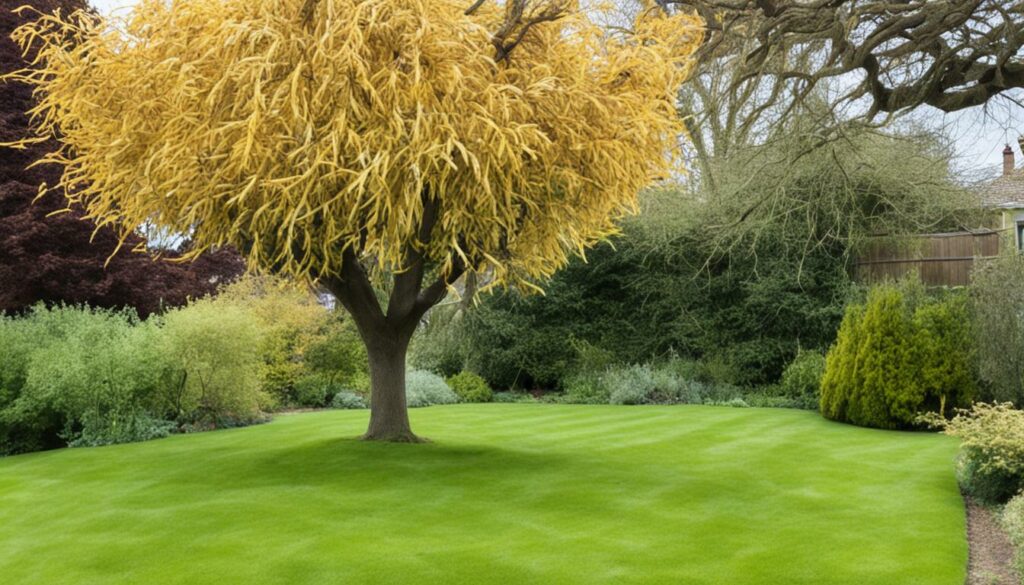
In spring, many gardeners get their fertilisation wrong. Choosing the right amount of fertiliser is key for plant health. This helps avoid problems like over-fertilisation.
It’s vital to do a soil test before adding any fertiliser. This test shows what your soil needs. It helps you pick the best fertilisers for your plants. Timing is also really important. Doing it at the right time boosts the results.
Always read the fertiliser’s instructions. This stops you from giving your plants too much or too little. How you put it on, whether liquid or granular, makes a difference. Granular types are great for even coverage on the lawn.
Choosing the right tools is also crucial. A broadcast spreader works better with dry fertilisers. It avoids uneven spots. Applying in a checkerboard pattern helps too. It prevents over-fertilisation.
Knowing your lawn’s size before buying fertiliser is smart. It prevents waste and possible damage from using too much. Consider products like Lawnifi for smarter feeding. They use nitrogen better and contain other nutrients needed by plants.
Getting advice from a pro is very valuable. They know a lot and can give tips just for your garden. Your Landscapers, in the NEPA area, have been helping since 2006. Their advice can lead to a beautiful, thriving garden.
Making sure plants can take up nutrients well after fertilising is very important. It’s key to water the right way to help nutrients mix well with the soil.
For liquid fertilisers, wait 2-4 hours before watering. With granular fertilisers, water the grass right after. This helps the granules break down and feed the soil with nutrients.
After fertilising, water the lawn for 20 minutes. This makes sure the soil is rightly moist for best nutrient absorption. Always aim for an inch of water every week to keep your lawn healthy.
It’s better to water deeply but not often than to water lightly a lot. Deep watering helps roots grow down. Doing this early in the day means less water evaporates, and the water goes deeper into the soil.
| Fertiliser Type | Recommended Watering Time | Additional Tips |
|---|---|---|
| Liquid Fertiliser | 2-4 hours post-application | Avoid puddles, water for 20 minutes |
| Granular Fertiliser | Immediately | Ensure thorough soil moisture |
| Water-Soluble Fertiliser | Within 24 hours | Follow up with additional watering if necessary |
| Slow-Release Fertiliser | Within 48 hours | Consider watering adjustments based on soil moisture |
Use a rain gauge to know how much it rains naturally. This helps avoid giving too much water. Setting up a smart irrigation system will also help. It adjusts water use based on the weather, saving water and keeping your lawn healthy.
If you get help from lawn care experts like Lawn Buddies, they might share videos on how to water after fertilising. This can make your lawn look better and be healthier by supporting the right nutrient use.
When we plan for spring fertilisation, we must think about the weather. The temperature and how much it rains affect how well fertiliser works. It’s key to choose the right fertiliser and how to use it to keep our plants healthy.

A big change in temperature can affect how well plants take in fertiliser. Crops that like warm weather might not grow well if it suddenly gets cold in spring. On the other hand, if it’s too cool, seeds might not grow at all.
If we get too much or too little rain, it’s a problem too. The right amount of water helps plants use the fertiliser well. But too much water can wash away the fertiliser, causing pollution.
Testing the soil can help us know exactly what nutrients our plants need. Using fertilisers that release nutrients slowly can also be a good idea. It makes sure our plants get the food they need, even if the weather keeps changing.
| Weather Factor | Impact on Fertilisation |
|---|---|
| Temperature Variations | Can hinder seed germination and plant growth |
| Precipitation Levels | Influences nutrient uptake and potential runoff |
| Excessive Rainfall | May cause nutrient leaching and environmental pollution |
| Dry Conditions | Reduces nutrient absorption and increases soil salinity |
It’s very important to consider the weather’s impact on your garden. Fertiliser is best used when spread evenly. This way, we don’t waste it or harm our water sources.
Using mulch and compost helps keep the garden healthy too. They save water and stop the soil from losing nutrients. This method, along with fertiliser, helps our garden cope with any weather.
Good spring lawn care is vital for healthy grass. It’s important to use the best fertiliser at the right times. This helps your lawn grow well and absorb nutrients properly.
Start fertilising in spring about three weeks after your grass turns green. Or, after the first few mows. This timing avoids helping weeds and stops fertiliser from washing away.
If you have crabgrass, it’s good to use a fertiliser early in spring that stops it.
For weeds like daisies, use weed and feed products when it’s 60 to 90 degrees outside. This temperature range is perfect for this kind of treatment. It will make your lawn healthier.
You should mow your lawn more often in spring and early summer. This is better for the grass’s looks and health. It helps with root growth and taking in nutrients.
Adding lime to your lawn in spring and autumn helps if your soil is too acidic. Do a soil test to check if you need to do this. New lawns should be tested once a year until the soil is balanced. Then, you can test every three years.
Soil pH testing is key. It helps you know what your lawn needs to grow well. This is important for deciding on the best fertilising plan.
| Spring Lawn Care Activity | Timing | Benefit |
|---|---|---|
| First Fertilisation | 3 Weeks After Greening | Promotes Growth |
| Crabgrass Preventer | Early Spring | Prevents Weed Growth |
| Weed and Feed Application | 60-90°F Temperatures | Controls Broadleaf Weeds |
| Mowing | Regularly (Spring) | Develops Healthy Roots |
| Watering | Weekly (1 inch) | Maintains Moisture |
| Lime Application | Based on Soil Test | Balances Soil pH |
| Soil Testing | Annually (New Lawns) | Informs Fertilisation |
Follow these tips for fertilising your lawn. Your lawn will stay beautiful and healthy all through spring and beyond.
Getting the fertilisation timing right is key for a lush garden. Apply fertiliser at key growth stages to make plants thrive. This way, they’ll get the nutrients they need most.
Cool-season grasses do best with fall fertilisation, their main growing time. But, warm-season grasses prefer to be fed in spring, helping them grow strong. Knowing when to care for your garden is important.

Don’t toss grass clippings away; they give natural nitrogen, great for the turf. Adding compost to your lawn introduces vital organic matter. This boosts growth even more.
Overseeding can make your lawn tough without starting from scratch. Pairing this with regular care, like soil tests and the right fertiliser, can do wonders for your grass.
Caring for your lawn four times a year, as it grows, ensures it thrives. This is the perfect schedule to follow:
| Season | Fertilisation Timing |
|---|---|
| Early Spring | February – April (when grass begins to green) |
| Late Spring | April – June (6 to 8 weeks after early spring feeding) |
| Summer | June – August (6 to 8 weeks after late spring feeding) |
| Fall | August – November (right before winter, 6 to 8 weeks after summer feeding) |
Scotts® Turf Builder® Halts Crabgrass Preventer and Scotts® Turf Builder® Triple Action target lawn issues. For eco-fans, try mulching and composting. They’re good for the earth.
Don’t overdo the fertiliser; it can hurt your lawn. Start with less than you think to be safe. Experts agree, this helps your grass grow strong without harm.
Exploring spring fertilisation shows us how important good timing and balance are. In places like Dallas, knowing when to fertilise is crucial for great gardening results. For instance, it’s best to fertilise trees from late February to early April.
Using natural fertilisers, such as compost and aged manure, can help meet plants’ needs and improve the soil. It’s vital to check on tree health and adjust fertiliser use. This helps avoid problems like too few nutrients or using too much, which is bad for the plants and nature.
Fertilising is even more effective when combined with proper watering, mulching, and pruning. Know the right soil and air temperatures, and learn about NPK ratios for the best growth. A well-thought-out fertilising plan, adjusted for what your plants need, is key to a healthy garden.
Start by using a mix of nitrogen, phosphorus, and potassium in spring. These help plants grow leaves, roots, and control water. The time you fertilise, testing soil, and how you apply it are also key.
Spring nutrients are vital as plants wake from winter sleep. Main nutrients like nitrogen boost leaves and new roots. So, spring is a critical time to feed your plants.
Choose organic or synthetic fertilisers depending on what your garden needs. Organics like compost slowly nourish soil. Synthetics offer a quick boost. The best pick fits your plants and your aims.
Know your soil’s nutrients and what your plants need. Test the soil to find out what’s lacking. Check the fertiliser label to match the nutrients to your garden.
For the lawn, choose a fertiliser for the specific grass type. It should help your grass grow without problems like runoff. Look for a kind that feeds your grass well.
For flowers, use a slow-release fertiliser. It won’t shock your plants but helps them bloom. Apply it carefully to each flowerbed so they get just enough.
Vegetables need different nutrients depending on the plant and its stage. Plan when and what to feed them. This makes sure they grow well and produces tasty food.
Plants have different needs in spring. Tomatoes want a lot of nitrogen for growth. Some herbs prefer a balanced mix. Know what your plants need to pick the right fertiliser.
To avoid problems like too much fertiliser, stick to the guidelines. Test your soil and choose balanced fertilisers. This keeps your plants healthy without harming the environment.
After fertilising, water your plants well. This helps the nutrients sink into the soil for the roots to use. It’s a key step for plant health.
Weather changes affect how fertiliser works. Be ready for temperature and rain effects on nutrients. By adjusting, you can keep plants healthy no matter the weather.
Pick the right fertiliser for your lawn and apply it at the right time. Use methods that avoid nutrient waste. These steps will help you have a vibrant, healthy lawn.
Timing is everything when fertilising in spring. Start early, just as plants wake up. This makes sure they get the nutrients they need right from the start.